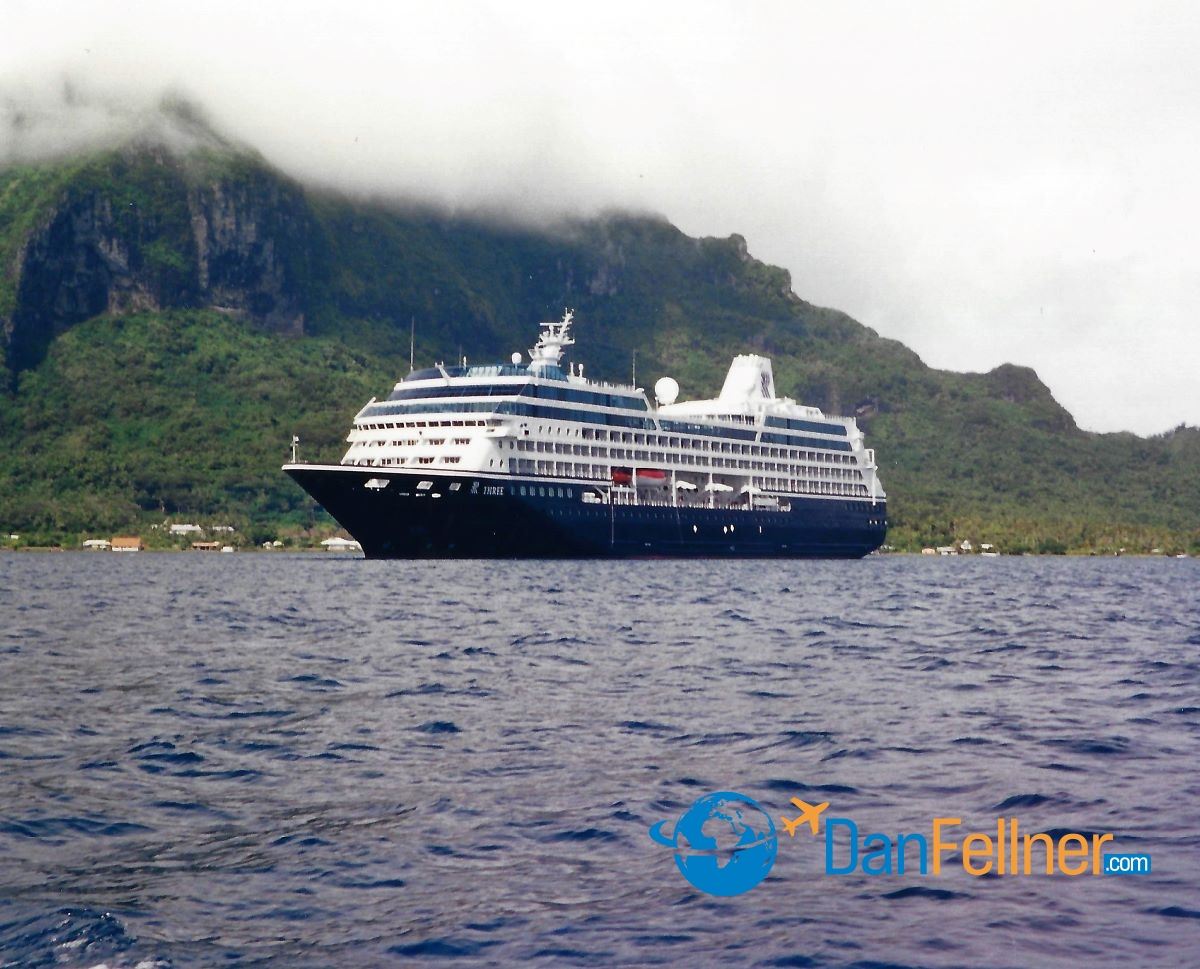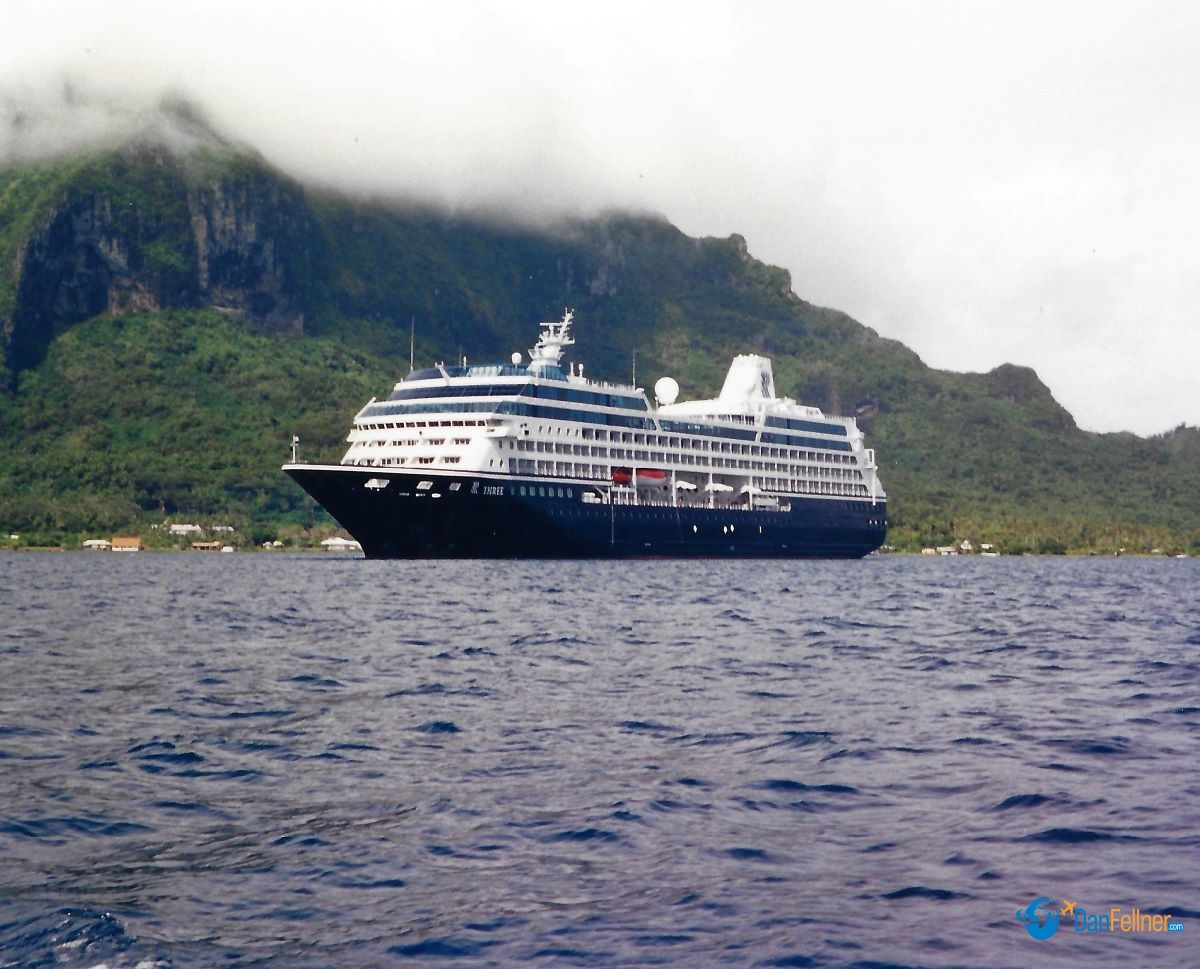Smaller size equals more relaxation, wider choice of itineraries
East Valley Tribune — February 25, 2001
FRENCH POLYNESIA — Whoever said that size doesn’t matter hasn’t been on a cruise ship.
While the newer, highly touted mega-ships — massive floating hotels that can accommodate 3,000-plus passengers with every amenity imaginable — attract more attention and bookings, many experienced cruisers say it’s the less glamorous smaller vessels that offer the best overall cruising experience.
They may not have all the bells and whistles of their larger counterparts, but smaller ships give passengers greater flexibility, a wider choice of itineraries, less time spent waiting in lines, and ultimately, a more intimate and relaxing vacation experience.
Still, the industry trend has been to build bigger and bigger ships. Of the 50 new cruise ships on order for delivery in the next four years, 27 will accommodate more than 2,000 passengers. Conversely, only nine will carry fewer than 1,000
After sampling a half-dozen ships over the years that carried anywhere from 1,500 to 2,500 passengers, I recently sailed through French Polynesia aboard Renaissance Cruises’ R3, a cozy, elegantly appointed 18-month-old French-built ship that holds just 684 passengers, not including the crew and staff. (Note: Renaissance Cruises filed for bankruptcy in 2001; The R3 was purchased by Princess Cruises in 2002 and now sails under the name “Pacific Princess.” Several of the other R-class ships are now operated by Oceania Cruises).

The R3 (now called the Pacific Princess) anchored in French Polynesia.
Renaissance is carving out a niche in the midsize cruise ship market. It has 10 ships in service around the world — none accommodate more than 700 passengers. And two of its vessels are relatively tiny all-suite ships that carry only 114 passengers. The company believes that smaller ships translate into more return customers, meaning it can spend less on marketing.
“Today’s cruise passengers are more demanding,” said Brad Ball, a spokesman for Renaissance (Brad is now the spokesman for Silversea Cruises, a high-end cruise line). “They want choices. They’re looking for a complete range of onboard amenities, as well as shore excursions that provide unique experiences while in port. However, they don’t want to vacation with 3,000 – 4,000 other travelers. With our ships, we provide all the amenities that consumers want, but without the crowds of the mega-ships.”
We noticed the difference as soon as we arrived in Papeete, Tahiti, after an eight-hour, nonstop Renaissance-chartered Hawaiian Airlines flight from Los Angeles. Getting from the plane to our ship’s cabin took a scant 30 minutes, the shortest embarkation process we’ve ever experienced. There were no lines — just the ship’s cruise director to personally greet each passenger.
It was a prelude to what awaited us during the next 10 days. Waiting in lines is as much a part of the mega-cruise experience as the midnight buffet. But on the R3, there were virtually no lines at all, except an occasional queue to board the tenders to take passengers into the ports where the ship couldn’t dock.
Perhaps the biggest difference between the large and smaller cruise ships involves the activity that is farm more important to some passengers than visiting exotic ports of call or soaking up sun by the pool — eating.
On many large ships, you must specify before the trip which one of two dinner seatings you prefer. The first seating is typically at 6:30 p.m. and the second follows two hours later. You are assigned to a table for the duration of the trip, and you have the same dinner companions night after night. If you tire of their company, there’s usually an option to eat at a buffet, but the food is a step down in quality.
Smaller ships, on the other hand, are able to provide much more flexibility. On the R3, you can eat dinner anytime between 6:30 and 9 p.m., depending on your mood. Want an intimate dinner one evening with your spouse? No problem, ask for a table for two. Or, if you meet some people during the course of the cruise that you want to dine with, that, too, can easily be arranged.
There’s also more flexibility on where you eat. In addition to a main dining room and the obligatory buffet, the R3 offers two specialty restaurants — the Grill and Italian Restaurant. Both serve up excellent cuisine in elegant surroundings. The only drawback is that you need to make a reservation a day or two in advance.
We also found the quality of food to be a notch above most of the larger ships we’ve been on. Quite simply, it’s easier to demonstrate culinary excellence when cooking for a few hundred people versus a few thousand.

And the best part of all is that you never have to get dressed up. Smaller ships tend to be more informal. The R3 had no “formal” nights, which would have required a jacket and tie. Instead, “country club casual” attire was acceptable every night, meaning no jeans, shorts or tennis shoes.
Packing for a cruise was never so easy. The informal dress code, plus the fact the ship has a self-service launderette that enable us to replenish our wardrobe halfway through the trip, meant that my wife and I were able to get by with just carry-on luggage. Not bad for a 10-day cruise.
The informality of smaller ships carries over into other aspects of the cruising experience. For instance, there are fewer disruptive announcements over the public address system than on a typical mega-ship. After awhile, you tired of hearing about the jackpot bingo being offered in the Mermaid Lounge or the shuffleboard tournament on Deck nine.
Some smaller ships even have an “open bridge” policy, allowing passengers to visit the navigation bridge at almost any time. We enjoyed watching the captain, perched behind the ship’s steering wheel, directing his crew as we sailed away from one of the French Polynesian Islands.
More diversity in ports-of-call is another advantage. Smaller ships can go to smaller and more exotic destinations simply because they can sail through narrower passageways and dock in more confined ports with shallower water.
On a recent cruise through the Baltic Sea, our 2,000-passenger ship had to dock an hour’s bus ride from Stockholm, Sweden, and 20 minutes outside of St. Petersburg, Russia. In both ports, we noticed smaller cruise ships docked right in the heart of town, within walking distance of the main attractions.
That’s not to say, though, that large ships don’t have their pluses. They perform better in bad weather, as they have the bulk to withstand rough seas. That can be vitally important if you’re prone to seasickness.
And they generally offer the widest range of activities and facilities. There’s always something to do, whether it be a ballroom dancing class, table tennis tournament, art auction or ice-carving demonstration. And the entertainment is typically better, with larger performing casts and all the glitz you’ll find in a Las Vegas floor show.
For those, though, who want a vacation that is a bit quieter and more laid back, try sailing aboard a ship that holds just a few hundred passengers. You’ll still have plenty of company and more than enough things to do – just not as many people to rub elbows with as you do it.
© 2009 Dan Fellner



